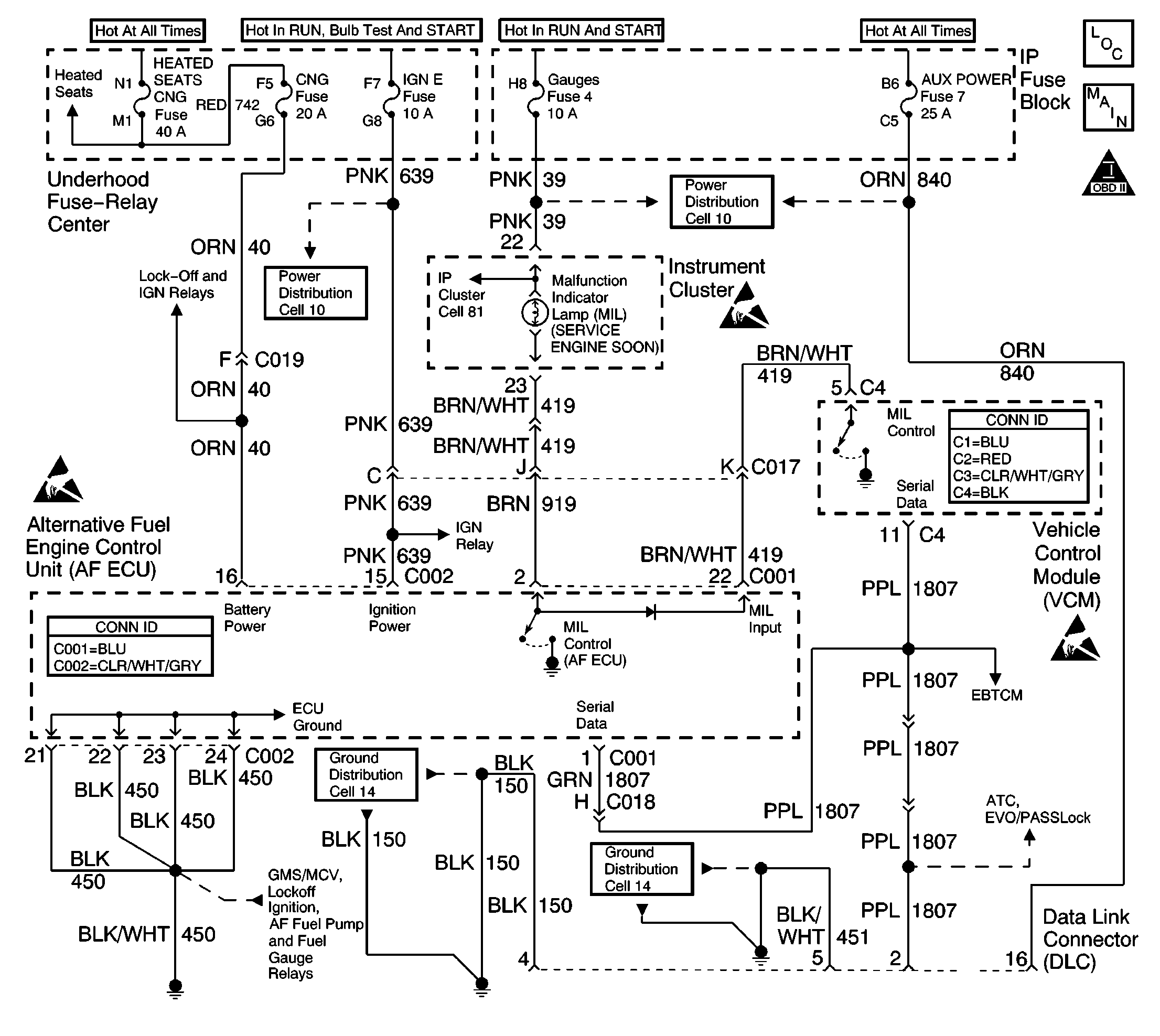
Circuit Description
The SERVICE ENGINE SOON Malfunction Indicator Lamp (MIL) is used to indicate to the driver of the vehicle that an engine control system condition has occurred that may cause an increase in emissions and/or cause a driveability concern.
When the ignition is first turned ON, the gasoline control module (VCM/PCM or ECM) will illuminate the MIL for a bulb and system check. When the engine is started and operating, the gasoline control module will turn the MIL OFF if no DTCs are set.
The AF ECU connects into the normal MIL Control circuit path and does not affect the gasoline control module operation of the MIL. The AF ECU is connected into the MIL control circuit path in order to command the MIL ON when a CNG DTC sets. Both the AF ECU and the gasoline control module simultaneously test certain DTCs regardless of the fuel system that is in operation and may illuminate the MIL.
The instrument panel gauge fuse supplies the positive voltage source for the MIL. The gasoline control module and/or the AF ECU can supply the ground path.
Test Description
The numbers below refer to the step numbers on the diagnostic table.
-
The AF Powertrain On-Board Diagnostic (OBD) System Check must be performed before proceeding with this diagnostic table. Failure to perform the OBD System Check will result in misdiagnosis.
-
With the ignition ON and the engine OFF, the gasoline control module (VCM/PCM or ECM) should continuously illuminate the MIL.
-
The scan tool will command BOTH the gasoline control module and the AF ECU to turn the MIL OFF.
-
This step tests if the MIL Input circuit is requesting MIL illumination. There should not be a MIL Input while the MIL is commanded OFF.
-
This step checks if a gasoline control module system failure is the cause of the inoperative MIL. The most likely cause of no MIL and a no start is a loss of voltage to the gasoline control module.
-
This step tests for an open MIL Input circuit. The gasoline control module should always command the MIL ON when the ignition is ON and the engine is OFF.
-
This step tests for an open MIL Control circuit or IP.
Step | Action | Value(s) | Yes | No |
|---|---|---|---|---|
Did you perform the AF Powertrain On-Board Diagnostic (OBD) System Check? | -- | Go to Alternative Fuels (AF) Powertrain On Board (OBD) System Check | ||
Turn ON the ignition, with the engine OFF. Is the MIL continuously illuminated? | -- | |||
While communicating with the AF ECU, command the MIL OFF. Is the MIL illuminated? | -- | |||
4 | The fault is not present. Refer to Diagnostic Aids. Is an operational concern still present? | -- | Go to Alternative Fuels (AF) Powertrain On Board (OBD) System Check | Go to Intermittent Conditions |
Observe the MIL Input (Gasoline) data parameter on the scan tool with the MIL commanded OFF. Is a gasoline MIL Input request present? | -- | |||
Crank the engine for at least 10 seconds. Does the engine start and run? | -- | |||
7 | Observe the operation of the other instrument panel (IP) gauges and/or lamps. Do all the IP indicators (except the MIL) operate correctly? | -- | ||
Is a gasoline MIL Input request present? | -- | |||
If the jumper fuse opens repair the short to voltage on the AF ECU MIL Control circuit. Is the MIL illuminated? | -- | |||
10 | The fault is in gasoline control module system. Refer to the Powertrain On Board Diagnostic (OBD) System Check in the C/K Truck Service Manual for diagnosis. Are all diagnosis and repairs of the gasoline system complete? | -- | -- | |
11 |
Was a repair necessary? | -- | ||
12 |
Was a circuit repair necessary? | -- | ||
13 |
Was a circuit repair necessary? | -- | ||
14 |
Was a circuit repair necessary? | -- | ||
15 |
Was a terminal repair necessary? | -- | ||
16 | The fault is in the instrument panel. Refer to Instrument Cluster System Check in Body and Accessories. Is the diagnosis and repair of the gasoline system complete? | -- | -- | |
17 |
Was a terminal repair necessary? | -- | ||
18 |
Important: The following control module replacement procedures must all be completed before attempting to operate the vehicle.
Important: In order to perform the variation learn procedure a switch-over to gasoline operation is necessary. Remove the CNG 20 amp fuse in order to perform the switch-over. All of the above procedures are located in the C/K Truck Service Manual. Is the replacement complete? | -- | -- | |
19 |
Is the replacement complete? | -- | -- | |
20 |
Does the vehicle operate on CNG with normal driveability, no FIL/MIL illumination, and no stored DTCs? | -- | System OK | Go to Alternative Fuels (AF) Powertrain On Board (OBD) System Check |
